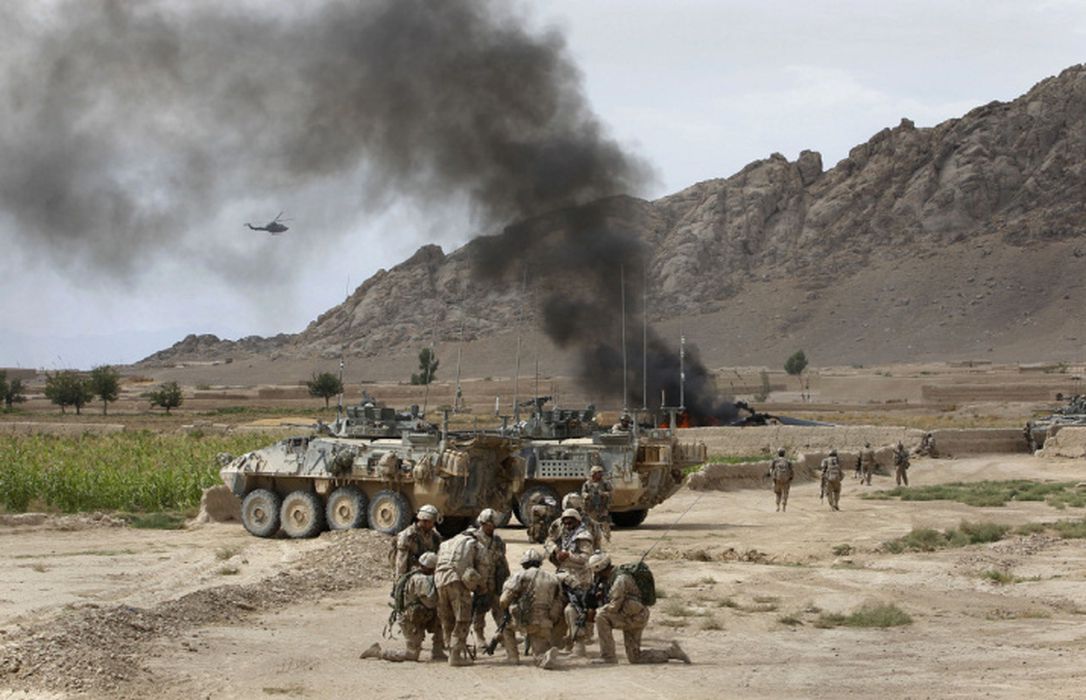
Canadian soldiers gather near a burning Canadian Forces CH-147 Chinook helicopter after it made a hard landing southwest of Kandahar. [Bob Strong/Reuters]
Airborne mission commander Captain William Todd Fielding was doing pre-landing checks as they headed into the forward operating base at Ma’sum Ghar, situated near Taliban strongholds. There were 13 soldiers, six crew and two U.S. civilians aboard the Chinook, known as Blowtorch 61.
After a loud bang, the aircraft shuddered and began flying through shrapnel. “Being a 20-tonne helicopter…it had to be something significant,” Fielding later recalled. Taliban weapons fire had hit a fuel tank and within seconds, he could hear screaming from the back, the cockpit had filled with black smoke, and the flight controls were not responding properly.
Training kicked in. “It was a bit surreal,” he recalled in an oral history project interview for the Canadian War Museum subsequently published in Canadian Military History.
He developed tunnel vision and tunnel hearing, blocking out the chaos around him, as he focused on keeping the helicopter upright and landing safely. He knew the stakes: if he botched the landing, it “would have been the worst day in Canadian military history in Afghanistan.”
There was no time to make it to their destination, return to Kandahar, or even fly a safer distance away. Fielding decided to put the bird down in a farmer’s field right in the middle of enemy territory.
He and his co-pilot Captain A.J.W. Mramor did an emergency shutdown and evacuation to get everyone out before the fuel exploded. His own emergency exit was jammed, and he had to exit through the fuselage, weighted down by 40 kilograms of equipment, and carrying his C8 assault rifle. The pilot, co-pilot and Master Corporal Alexander Gorrie, who was pushing people through a tight space, were the last to get off.
They hunkered down beside a mud wall about 40 metres away, in what Fielding described as a “lose/lose situation.” They could get behind the wall to avoid shrapnel from the helicopter that was about to explode, or go to the other side, the enemy’s side.
Over they went, and flattened to the ground. Bullets hit the wall around them.
Fielding tried putting out an SOS to the two Griffons, but there was just static on every frequency. Just as Fielding was thinking, “I probably won’t see my kids again,” the ammunition on the helicopter started cooking off. “We think that probably helped keep the insurgents at bay because so many rounds were going off it sounded like machine guns.”
Major C.D. Lillington took command on the ground, and decided it was best they make for the base. The men at first leopard-crawled through rocks and prickly bushes, then ran from ditch to ditch, taking cover where they could. Fielding guided an unarmed doctor through the ordeal.
After a while, a Canadian light armoured vehicle arrived, then another. The helicopter passengers and crew took refuge inside the LAVs, listening to bullets pinging off the armoured plating, while troops outside engaged the Taliban in a long firefight.
Flooded with adrenaline, Fielding was so antsy that half a dozen times he found himself popping up through the hatch to assess the situation.
Finally, the LAVs began moving to the forward operating base. Since IEDs had claimed so many Canadian troops, “I was bracing myself, sitting there, waiting for a ‘Kaboom!’
Everyone who had been aboard the helicopter made it to safety, where it was determined they had all suffered minor injuries. Their last trip of the day was by helicopter to the hospital in Kandahar.
Fielding was awarded the Medal of Military Valour for actions “that no doubt saved the lives of all crew and passengers that day,” says the citation. Gorrie received a Chief of the Defence Staff Commendation for “outstanding selflessness and composure amidst harassing enemy fire.”
Mramor and Lillington received Mentions in Dispatches for their composure, professionalism and leadership.
Advertisement





















